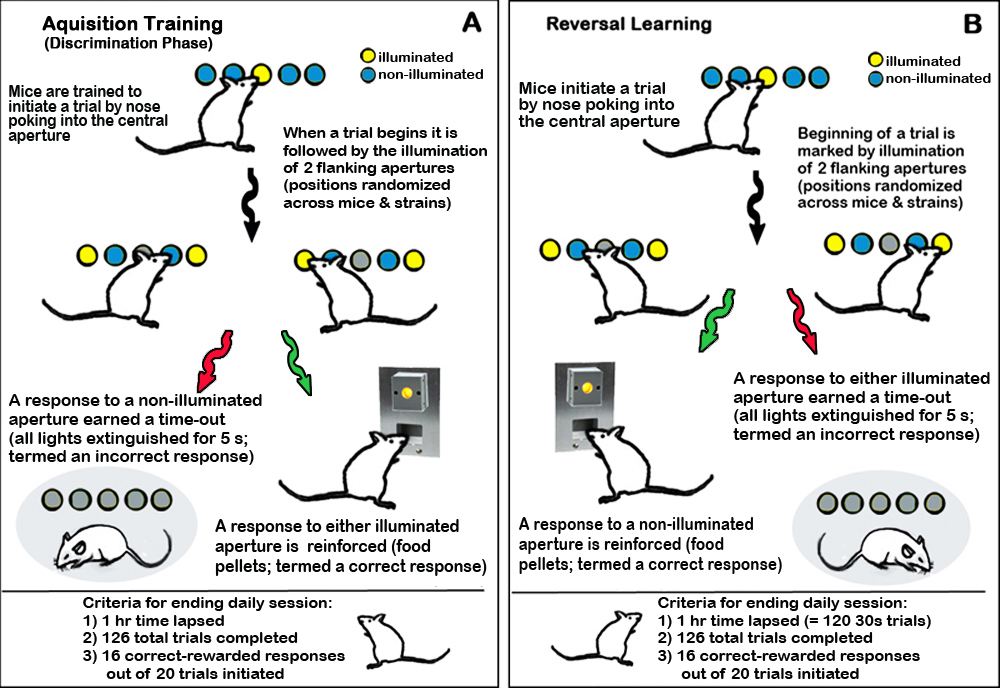Jentsch1 project protocol
Reversal learning in males of 51 BXD recombinant inbred strains of mice (2011)
Jentsch JD, Williams RWWith: Laughlin RE, Grant TL
Project protocol — Contents
Workflow and sampling
Equipment and supplies
Reagents and solutions
Procedure for training and assessing reversal learning
Definitions
Data
ReferencesWorkflow
Mice assessed for reversal learning (Fig. 1B)
- Balance scale
- Operant conditioning chambers fitted with a horizontal array of five nose-poke apertures on one side of the box and a photocell-equipped food delivery magazine on the other side, Med Associates (St. Albans, Vermont).
- Food pellets
Procedure for training and assessing reversal learning
a. Ad libidum-feeding body weight is obtained before administering food restriction.
b. Three to 5 days before the start of training, mice are placed on a restricted diet in their home cages sufficient to achieve a 10% to 15% reduction in their free-feeding weight at the start of testing, and then adjusted up to a 20% reduction during testing.
c. Mice are then trained and tested daily in individual operant conditioning chambers fitted with a horizontal array of five nose-poke apertures on one side of the box and a photocell-equipped food delivery magazine on the other side.
d. The mice are trained to initiate trials by nose poking into the central aperture, triggering illumination of flanking apertures (Fig. 1A).
e. Responding in one of the two illuminated apertures is reinforced with a food pellet (termed a correct response), while responses at the other aperture earned a time-out with all lights extinguished for 5 s (termed an incorrect response).
f. The aperture reinforced during initial training is randomized across individual mouse and strains.
g. Mice are tested in daily sessions that end after one of the following criteria are met: 1) 1 hour lapse; 2) 126 trials; or 3) achieving 16 out of 20 correctly completed trials (performance criterion). Computing the performance criterion as a moving window of 20 trials ensures that mice are consistently sampling from the reinforced hole, ruling out generic hyperactivity or disinhibited responding as a factor contributing to successful stage completion.
h. Once a performance criterion is met within a session, testing on that day is stopped and the reinforcement contingencies are reversed beginning in the following session (Fig. 1B).
i. After mice are trained during the discrimination phase, they are tested for reversal learning with trials initiated by nose poking into the central aperture, triggering illumination of flanking apertures (Fig. 1B).
j. Unlike the discrimination phase, responses in one of the two illuminated apertures are followed by time-out with all lights extinguished for 5 s (termed an incorrect response), while responses at the other aperture are reinforced with a food pellet (termed a correct response).
k. As in the acquisition phase, the aperture reinforced during initial training is randomized across individual mice and strains.
l. Reversal learning session is ended after: 1) 1 hour; 2) 126 trials; or 3) achieving the performance criterion of 16 out of 20 correctly completed trials (computed as a moving window).
m. The primary outcome measures are the number of trials required to reach performance criterion (trials to criterion [TTC]) and their latencies during the initial acquisition and reversal conditions.Figure 1. Schematic of operant conditioning for assessing reversal learning.
initiated trial: trial initiated by a nose poke into the central aperture, triggering illumination of flanking aperture during acquisition and reversal training
no choice made: following the initiation of a trial, a mouse fails to nose poke into flanking apertures within a block of 30 s, computed as a moving window during acquisition and reversal training
anticipatory nose poke: nose pokes made following an incorrect response, or nose poke into flanking aperture and resulting in all lights extinguished for 5 s during acquisition and reversal training
trial initiation latency: amount of time lapsed between the termination of a trial the beginning of a new trial during acquisition and reversal training
correct choice latency: amount of time lapsed following a nose poke of flanking apertures eliciting a food pellet as a reward during acquisition and reversal training
reward retrieval latency: amount of time lapsed following the presentation of a food pellet as a reward and its retrieval or consumption during acquisition and reversal training
Data collected by investigator
• acquisition training performance: number of initiated trials, no choice made, and anticipatory nose pokes
• acquisition training latencies: trial initiation, correct choice, and reward retrieval
• reversal training performance: number of initiated trials, no choice made, and anticipatory nose pokes
• reversal training latencies: trial initiation, correct choice, and reward retrieval
